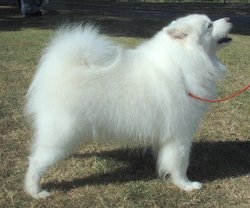
Smiling Sammy
|
From Wikipedia the free encyclopedia, by MultiMedia |
| Samoyed | |
|---|---|

|
|
| Alternative names | |
| Samoiedskaпa Sobaka | |
| Country of origin | |
| Russia | |
| Common nicknames | |
| The smiley Dog Smiling Sammy |
|
| Classification and breed standards | |
| FCI: | Group 5 Section 1 #212 |
| AKC: | Working |
| ANKC: | Group 6 (Utility) |
| CKC: | Group 3 - Working Dogs |
| KC (UK): | Pastoral |
| NZKC: | Utility |
| UKC: | Northern Breeds |
| Not recognized by any major kennel club | |
| This breed of Dog is extinct | |
| Notes | |
The Samoyed Dog takes its name from an obsolete term for the Nenets people of Siberia. These nomadic reindeer herders bred the fluffy, white, smiling Dogs to help with the herding, to pull sleds when they moved, and to keep their owners warm at night by sleeping on top of them.
Males typically reach sizes of up to 65 pounds, while females typically remain less than 55 pounds.
Samoyed eyes should be black or brown, and are almond in shape. Blue or other color eyes are not allowed in the show ring.
Samoyed ears are thick and well-furred, triangular in shape, and erect.
The Samoyed tail is one of the breed's more distinguishing features. Like their Siberian Husky cousins, their tail is carried curled over their backs; however, unlike the Husky, the Samoyed tail is held actually touching the back in a tight curl. In cold weather, Samoyeds may sleep with their tails over their noses to provide additional warmth. Some Samoyeds have tails that fall straight down the backside, like many other breeds, but this prevents them from being show quality.
Much like Siberian Huskies, Samoyeds have a dense, double layer coat that is typically shed twice a year, although some shed only once a year. The top layer contains long, coarse, and straight guard hairs, which appear white but have a hint of silver coloring. This top layer keeps the undercoat relatively clean and free of debris. The under layer (or undercoat) consists of a dense, soft, and short fur that keeps the Dog warm. The standard Samoyed may come in a mixture of biscuit and white coloring, although pure white and all biscuit Dogs aren't uncommon.
Samoyeds are typically very good about grooming themselves, and upkeep as far as bathing is minimal. Dirt typically falls from the outer layer of fur with little work, making the Dog deceptively easy to keep very clean looking. Puppy fur is more porous and will tend to take on the color of grass or mud if the Dog spends a lot of time in appropriate environments.
Samoyeds' friendly disposition makes them poor guard Dogs, but excellent companions, especially for small children or even other Dogs, and they remain playful into old age. Samoyeds are also known to be stubborn at times and difficult to train, due to unwillingness rather than lack of intelligence; they must be persuaded to obey commands. With their sled Dog heritage, a Samoyed is not averse to pulling things, and an untrained Samoyed has no problem pulling its owner on a leash rather than walking alongside.
The Samoyed name quickly become obsolete for the Nenets people after the Russian Revolution (perceived as derogatory; see Nenets article). However, by then, Arctic explorers (for example, Fridtjof Nansen and Roald Amundsen) had brought enough of the Dogs back to Europe to keep the name and to establish the breed both there and in the US.
Fridtjof Nansen believed that the use of sled Dogs was the only effective way to explore the north and used Samoyeds on his polar expeditions. Unfortunately, his plan was disasterous to the animals, as he planned to feed the weaker Dogs to the stronger ones as they died during the expedition. In the end, he lost almost all of his Dogs due to his plan.
Roald Amundsen used a team of sled Dogs led by a Samoyed named Etah on the first expedition to reach the South Pole.
Recent DNA analysis of the breed has led to the Samoyed being included amongst the fourteen most ancient Dog breeds [1], along with Siberian Huskies, Alaskan Malamutes, the Chow Chow, and 10 others of a diverse geographic background.
Dogs, made by MultiMedia | Free content and software
This guide is licensed under the GNU Free Documentation License. It uses material from the Wikipedia.